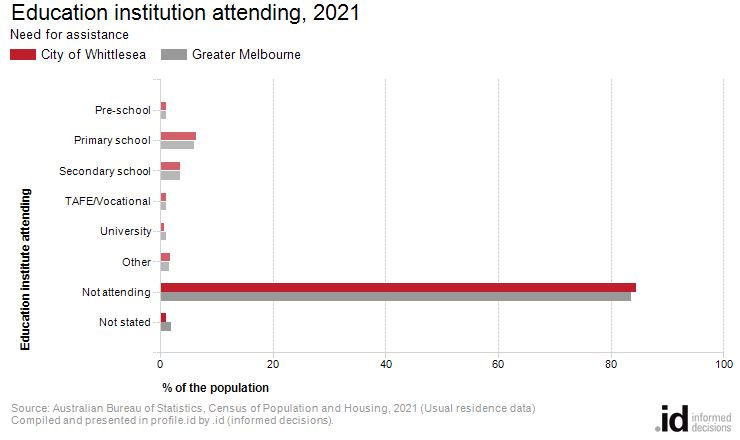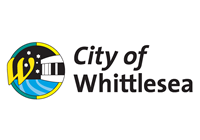City of Whittlesea
Need for assistance - Education institution attending
In 2021, 14.5% of people who needed assistance in the City of Whittlesea attended an educational institution.
This dataset shows the educational attendance of the population needing assistance with daily tasks (due to age or disability) in City of Whittlesea. Educational attendance is highly correlated with age, with children having the highest level of educational attendance generally. For the population with a disability, this dataset can reveal demand for assistance in the school system, and the level to which people with a need for assistance are able to access tertiary education.
To continue building the demographic story of those needing assistance in City of Whittlesea, please view this topic in conjunction with Age Structure and Qualification.
Derived from the Census question:
'What type of educational institution is the person attending?'
People with a need for assistance
| Education institution attending | ||||||||
|---|---|---|---|---|---|---|---|---|
| City of Whittlesea - Need for assistance | 2021 | 2011 | Change | |||||
| Type of institution | Number | % | Greater Melbourne | Number | % | Greater Melbourne | 2011 to 2021 | |
| Pre-school | 162 | 1.1 | 1.1 | 59 | 0.7 | 0.7 | +103 | 7001 |
| Primary school | 919 | 6.4 | 6.0 | 353 | 4.4 | 4.4 | +566 | 7002 |
| Secondary school | 500 | 3.5 | 3.6 | 202 | 2.5 | 2.5 | +298 | 7006 |
| TAFE/Vocational | 151 | 1.0 | 1.1 | 65 | 0.8 | 0.8 | +86 | 7010 |
| University | 114 | 0.8 | 1.1 | 36 | 0.4 | 0.6 | +78 | 7011 |
| Other | 249 | 1.7 | 1.7 | 128 | 1.6 | 1.5 | +121 | 7012 |
| Not attending | 12,180 | 84.4 | 83.6 | 6,779 | 84.3 | 84.5 | +5,401 | 7013 |
| Not stated | 151 | 1.0 | 1.9 | 422 | 5.2 | 4.9 | -271 | 7014 |
| Total Population | 14,426 | 100.0 | 100.0 | 8,044 | 100.0 | 100.0 | +6,382 | |
Source: Australian Bureau of Statistics, Census of Population and Housing (opens a new window) 2011 and 2021. Compiled and presented by .id (opens a new window)(informed decisions).

Compiled and presented in profile.id by .id (informed decisions).

Compiled and presented in profile.id by .id (informed decisions).
Dominant groups
Analysis of the share of the population needing assistance attending educational institutions in the City of Whittlesea in 2021 compared to Greater Melbourne shows that there was a similar proportion attending primary school, a similar proportion attending secondary school, and a similar proportion engaged in tertiary level education.
Overall, 6.4% of the population were attending primary school, 3.5% of the population were attending secondary institutions, and 1.8% were learning at a tertiary level, compared with 6.0%, 3.6% and 2.2% respectively for Greater Melbourne.
There were no major differences between City of Whittlesea and Greater Melbourne in 2021.
Emerging groups
From 2011 to 2021, City of Whittlesea's population needing assistance increased by 6,382 people (+79.3%). This represents an average annual change of 6.02% per year over the period.
The largest changes in the number of people needing assistance attending education institutions in the City of Whittlesea, between 2011 and 2021 were:
- Not attending (+5,401 persons)
- Primary school (+566 persons)
- Secondary school (+298 persons)
- Not stated (-271 persons)
